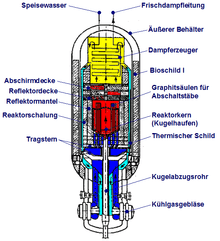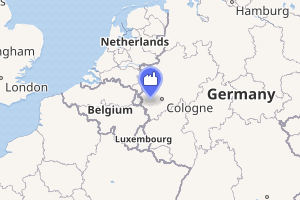AVR reactor
The AVR reactor (German: Arbeitsgemeinschaft Versuchsreaktor) was a prototype pebble bed reactor, located immediately adjacent to Jülich Research Centre in West Germany, constructed in 1960, grid connected in 1967 and shut down in 1988. It was a 15MWe, 46 MWt test reactor used to develop and test a variety of fuels and machinery.

| AVR reactor | |
|---|---|

| |
| Country | Germany |
| Coordinates | 50°54′11″N 6°25′16″E |
| Status | Decommissioned |
| Construction began | 1961 |
| Commission date | May 19, 1969 |
| Decommission date | December 31, 1988 |
| Power generation | |
| Units decommissioned | 1 x 15 MW |
| Capacity factor | 50.0% |
| Annual net output | 65.7 GWh |
| External links | |
| Commons | Related media on Commons |
The AVR was based on the concept of a "Daniels pile" by Farrington Daniels, the inventor of pebble bed reactors. Rudolf Schulten is commonly recognized as the intellectual father of the reactor.
A consortium of 15 community electric companies owned and operated the plant. Over its lifetime the reactor had many accidents, earning it the name "shipwreck." From 2011-2014, outside experts examined the historical operations and operational hazards and described serious concealed problems and wrongdoings in their final 2014 report. For example, in 1978 operators bypassed reactor shutdown controls to delay an emergency shutdown during an accident for six days. In 2014 the JRC and AVR publicly admitted to failures.
Its decommissioning has been exceptionally difficult, time-consuming and expensive. Since the original operators were overwhelmed by the effort, government agencies took over dismantling and disposal. In 2003 the reactor and its nuclear waste became government property. the temporary storage of 152 casks of spent fuel has been a controversy since 2009. The approval expired in 2013, because stress tests could not sufficiently demonstrate safety; no permanent solution has been reached. since 2012 plans to export the casks to the United States have been considered due to the extremely high disposal expenses. In 2014, a massive concrete wall to protect against terrorist plane crashes was to be built. On July 2, 2014 the Federal Environment ministry issued an evacuation order for the temporary storage.
AVR was the basis of the technology licensed to China to build HTR-10 and the HTR-PM, which is under construction as of January 2018.
History
In 1959, 15 municipal electric companies established the 'Association of Experimental Reactor GmbH' (AVR Ltd) to demonstrate the feasibility and viability of a gas-cooled, graphite-moderated high temperature reactor. In 1961, BBC and Krupp began AVR construction, led by Rudolf Schulten, performed on almost purely industrial basis until 1964. The federal government provided financial assistance, supported by the politician and founder of the Juelich Research Center (JRC), Leo Brandt.[1] In 1964, Schulten became Director of the JRC and started to devote more attention to the pebble bed reactor. In 1966, AVR first achieved criticality, and was connected to the national power grid in 1967. Construction cost figures vary between 85 and 125 million Deutsche marks ($2.5–3.7bn in 2014).[2] Since about 1970 the AVR GmbH was de facto dependent on JRC, although it remained formally independent until 2003. JRC provided generous operating grants to the AVR GmbH to ensure continued operation, since electricity generation only covered a small part of the operating costs. In the mid-1970s annual revenue was about 3 million DM, versus operating and fuel disposal costs of 11 million DM.[3] JRC also subsidized AVR through procurement and disposal of fuel as JRC has been owner of AVR fuel. In addition, the AVR operation was scientifically supervised by JRC.
During its initial years the AVR was nominally operated with cooling gas outlet temperatures of 650–850 °C. In February 1974, the cooling gas outlet temperature was raised to 950 °C.[4] These final high temperatures were a world record for nuclear facilities,[5] though later exceeded by the US test reactor UHTREX.[6] Such high temperatures were supposed to demonstrate the suitability of the AVR for coal gasification, and thus contribute to long term plans for coal in Northrhine-Westfalia. Because a pebble bed core cannot be equipped with instruments, the high AVR core temperatures were unknown until one year before the AVR shut-down, in 1988.
In 2000, AVR admitted that it was contaminated with 100 TBq 90
Sr
, being the most heavily 90
Sr
contaminated nuclear facility worldwide.[7]:4
Contamination
AVR´s helium outlet temperature was 950 °C, but fuel temperature instabilities occurred during operation with localised exceedingly high temperatures. As a consequence the whole reactor vessel became heavily contaminated by Cs-137 and Sr-90.[8] Concerning beta-contamination AVR is the highest contaminated nuclear installation worldwide as AVR management confirmed 2001.[9] During a severe water accident in 1978, Sr-90 leaked and soil and groundwater contamination below the reactor was discovered in 1999, as confirmed by the German government in February 2010.[10][7]:10 Thus in 2008, the reactor vessel was filled with light concrete to fixate the radioactive fine particule dust.[11] In 2012, the reactor vessel of 2100 metric tons was to be transported about 200 meters by air-cushion sled and seven cranes to an intermediate storage site.
Decommissioning
Fuel removal out of AVR was difficult and lasted 4 years. During this time it became obvious that the AVR bottom reflector was broken; about 200 fuel pebbles remain wedged in its crack. Currently no dismantling method for the AVR vessel exists. It is planned to develop some procedure during the next 60 years and to start with vessel dismantling at the end of the 21st century. After the AVR vessel is moved into intermediate storage, the reactor buildings will be dismantled, and soil and groundwater will be decontaminated. Costs from 1988 to present are €700 million. The total AVR decommissioning costs are expected to be in the order of 1.5 – 2.5 billion € , all public funds, i.e. to exceed its construction costs by far.
Independent expert review report, 2014
From 2011-2014, outside experts examined the historical operations and operational hazards In April 2014 published a report on the AVR operation.[12] The report listed hidden or downplayed events and accidents and described serious concealed problems and wrongdoings. For example, in 1978 operators bypassed reactor shutdown controls to delay an emergency shutdown during an accident for six days. In 2014 the JRC and AVR publicly admitted to failures and issued a regret about its failures and scientific misconduct with respect to the AVR.[13]
References
- B. Mittermaier, B. Rusinek: Leo Brandt (1908 – 1971) Ingenieur – Wissenschaftsförderer – Visionär Wissenschaftliche Konferenz zum 100. Geburtstag des nordrhein-westfälischen Forschungspolitikers und Gründers des Forschungszentrums Jülich Archived February 2, 2014, at the Wayback Machine S. 20 ff
- U. Kirchner Der Hochtemperaturreaktor Campus Forschung Bd. 667 (1991)
- Wird Jülichs Reaktor zur Atomruine? Welt am Sonntag, July 9, 1978
- Haag, G.; Delle, W.; Kirch, N.; Nickel, H.; Reinhart, K.; Ziermann, E. "Results of the visual in-pile inspection of the inner graphite reflector of the AVR". International Atomic Energy Agency. Retrieved 4 May 2015.
- "PowerPoint-Präsentation - Zeitstrahl 1956-2006: 27. 2. 1974 Weltrekord: Der Jülicher Hochtemperaturreaktor AVR erreicht 950 °C" (PDF). fz-juelich.de. p. 15. Archived from the original (PDF) on 2012-01-29. Retrieved 2014-01-26.
- J. Elder, M. Salazar (1992-08-01). "Decommissioning the UHTREX Reactor Facility at Los Alamos, New Mexico; Chapter 1.1". osti.gov. doi:10.2172/7004358. OSTI 7004358. Cite journal requires
|journal=(help) - R. Moormann Decommissioning problems of German pebble bed reactors 14 pages, NURIS-1, Vienna, 16/17 April 2015
- Moormann, R AVR prototype pebble bed reactor: a safety re-evaluation of its operation and consequences for future reactors Kerntechnik, Issue 2009/01-02 (in English)
- Mark Hibbs, Decommissioning costs for German Pebble Bed Reactor escalating, NUCLEONICS WEEK, Vol. 43, No.27, p7 (July 2002)
- Bundestag Betrieb des Forschungsreaktors AVR Jülich außerhalb sicherheitstechnischer Grenzen paper 17/843 24.February 2010(German)
- Fachinger, Johannes; Barnert, Heiko; Kummer, Alexander; Caspary, Guido; Seubert, Manuel; Koster, Albert; Makumbe, Munyaradzi; Naicker, Lolan (2008). "Examination of Dust in AVR Pipe Components". Fourth International Topical Meeting on High Temperature Reactor Technology, Volume 1. pp. 591–602. doi:10.1115/HTR2008-58033. ISBN 978-0-7918-4854-8.
- Der Versuchsreaktor AVR- Entstehung, Betrieb und Störfälle Abschlussbericht der AVR-Expertengruppe 1. April 2014, 167pp (German)(German)
- Forschungszentrum Jülich Stellungnahme des Forschungszentrums zum Bericht der AVR-Expertengruppe Last update: 8.1.2016
External links
- Jülich Research Centre.
- The Pebble Bed Evolution June 2005 (PDF, 17KB).
- Moormann, Rainer A safety re-evaluation of the AVR pebble bed reactor operation and its consequences for future HTR concepts Berichte des Forschungszentrums Jülich 4275,ISSN 0944-2952, 51pp, 2008 (8 pp abstract in English)